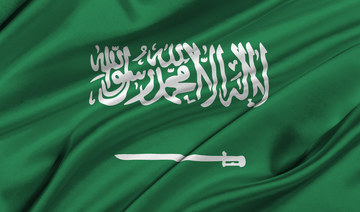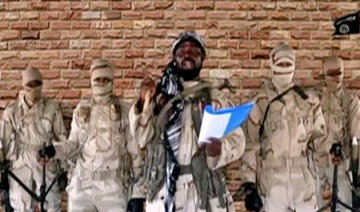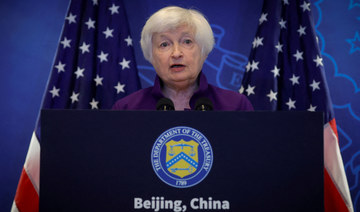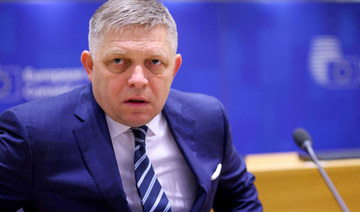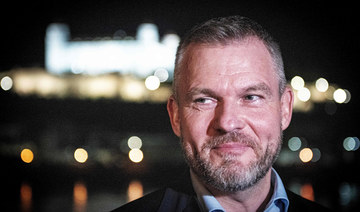NIAMEY: Militant-hit Niger last week killed about 30 members of the Boko Haram group and detained 960 followers, most of them women and children, who had fled neighboring Nigeria, official sources said.
State TV channel Tele Sahel said late Tuesday that on March 7 aerial surveillance spotted a “massive movement of people” along the Kamadougou Yoge River, which marks the border between the two countries, who were heading toward Lke Chad.
The report said they were members of the Boko Haram militant group, who were fleeing their hideout in Sambisa forest in northeast Nigeria after coming under pressure from their rivals, the Islamic State West Africa Province (ISWAP).
ISWAP split from Boko Haram in 2016 and rose to become the dominant group in the region’s long-running militant turmoil.
It seized swathes of territory under Boko Haram control after leader Abubakar Shekau was killed in clashes with ISWAP in May 2021.
Seeking to prevent the group from reaching Lake Chad and using its marshlands as a haven, the army tried to negotiate a surrender, using envoys and dropping leaflets, but eventually launched a dawn assault on March 11, Tele Sahel said.
“Around 30 terrorists were neutralized” and 960 other people, most of whom were women and children, were detained, taken to the town of Diffa and handed over to the Nigerian military authorities, it said.
An elected official in Toumour, a village near the town of Bosso bordering Lake Chad, confirmed Wednesday that “a large number of Boko Haram” fleeing Sambisa had been intercepted on Niger’s border “and handed over to the Nigerian authorities.”
Another official said that many others, however, “are heading toward (the islands) on the lake, especially women and children, in terrible conditions.”
One of the poorest countries in the world, Niger is being assailed by two militant insurgencies.
One, in the southwest, came from neighboring Mali in 2015, while the other, in the southeast, is a long-running spillover from Boko Haram’s campaign in Nigeria.
The group’s violence has killed over 40,000 people and displaced around two million from their homes since 2009, according to the United Nations.
The vast Lake Chad region, shared by Nigeria, Niger, Cameroon and Chad, is a notorious bolthole for both Boko Haram and ISWAP, who set up camps on islands in its marshlands.
The four countries set up a Multinational Joint Task Force in 2015, comprising 8,500, with the aim of defeating the armed groups.
Niger says it killed ‘30 militants’, arrests 960
https://arab.news/mbs43
Niger says it killed ‘30 militants’, arrests 960
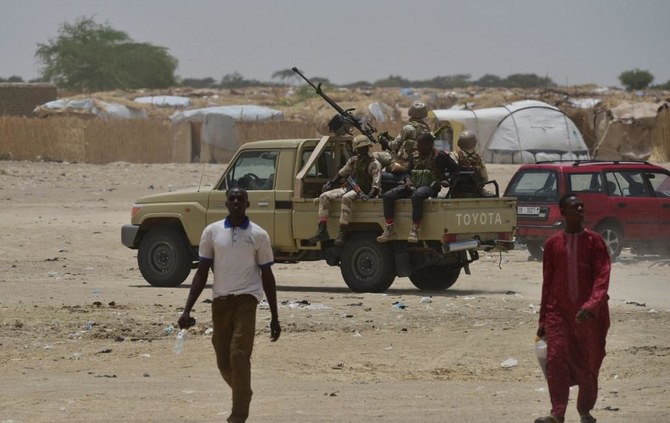
- One of the poorest countries in the world, Niger is being assailed by two militant insurgencies
Dance videos of Modi, rival turn up AI heat in India election

- Videos created using AI underscore how its use and abuse is increasing and creating worries for regulators
- WEF says risk to India from misinformation higher than risk from infectious diseases, illicit economic activity
NEW DELHI: An AI video shows an ecstatic Narendra Modi sporting a trendy jacket and trousers, grooving on a stage to a Bollywood song as the crowd cheers. The Indian prime minister reshared the video on X, saying “such creativity in peak poll season is truly a delight.”
Another video, with the same stage setting, shows Modi’s rival Mamata Banerjee dancing in a saree-like outfit, but the background score is parts of her speech criticizing those who quit her party to join Modi’s. State police have launched an investigation saying the video can “affect law and order.”
The different reactions to videos created using artificial intelligence (AI) tools underscore how the use and abuse of the technology is increasing and creating worries for regulators and security officials as the world’s most populous nation holds a mammoth general election.
Easy to make AI videos, which contain near-perfect shadow and hand movements, can at times mislead even digitally-literate people. But risks are higher in a country where many of the 1.4 billion people are tech challenged and where manipulated content can easily stir sectarian tensions, especially at election time.
According to a World Economic Forum survey published in January, the risk to India from misinformation is seen higher than the risk from infectious diseases or illicit economic activity in the next two years.
“India is already at a great risk of misinformation — with AI in picture, it can spread at the speed of 100X,” said New Delhi-based consultant Sagar Vishnoi, who is advising some political parties on AI use in India’s election.
“Elderly people, often not a tech savvy group, increasingly fall for fake narratives aided by AI videos. This could have serious consequences like triggering hatred against a community, caste or religion.”
The 2024 national election – being held over six weeks and ending on June 1 – is the first in which AI is being deployed. Initial examples were innocent, restricted to some politicians using the technology to create videos and audio to personalize their campaigns.
But major cases of misuse hit the headlines in April including deepfakes of Bollywood actors criticizing Modi and fake clips involving two of Modi’s top aides that led to the arrest of nine people.
DIFFICULT TO COUNTER
India’s Election Commission last week warned political parties against AI use to spread misinformation and shared seven provisions of information technology and other laws that attract jail terms of up to three years for offenses including forgery, promoting rumors and enmity.
A senior national security official in New Delhi said authorities are concerned about the possibility of fake news leading to unrest. The easy availability of AI tools makes it possible to manufacture such fake news, especially during elections, and it’s difficult to counter, the official said.
“We don’t have an (adequate monitoring) capacity...the ever evolving AI environment is difficult to keep track of,” said the official.
A senior election official said: “We aren’t able to fully monitor social media, forget about controlling content.”
They declined to be identified because they were not authorized to speak to media.
AI and deepfakes are being increasingly used in elections elsewhere in the world, including in US, Pakistan and Indonesia. The latest spread of the videos in India shows the challenges faced by authorities.
For years, an Indian IT ministry panel has been in place to order blocking of content that it feels can harm public order, at its own discretion or on receiving complaints. During this election, the poll watchdog and police across the nation have deployed hundreds of officials to detect and seek removal of problematic content.
While Modi’s reaction to his AI dancing video — “I also enjoyed seeing myself dance” — was light hearted, the Kolkata city police in West Bengal state launched an investigation against X user, SoldierSaffron7, for sharing the Banerjee video.
Kolkata cybercrime officer, Dulal Saha Roy, shared a typed notice on X asking the user to delete the video or “be liable for strict penal action.”
“I am not deleting that, no matter what happens,” the user told Reuters via X direct messaging, declining to share their number or real name as they feared police action. “They can’t trace (me).”
Election officers told Reuters authorities can only tell social media platforms to remove content and are left scrambling if the platforms say the posts don’t violate their internal policies.
VIGGLE VIDEOS
The Modi and Banerjee dancing videos, with 30 million and 1.1 million views respectively on X, were created using a free website, Viggle. The site allows a photograph and a few basic prompts that are detailed in a tutorial to generate videos within minutes that show the person in the photograph dancing or making other real-life moves.
Viggle co-founder Hang Chu and Banerjee’s office did not respond to Reuters queries.
Other than the two dancing AI videos, one other 25-second Viggle video spreading online shows Banerjee appear in front of a burning hospital and blowing it up using a remote. It’s an AI altered clip of a scene from the 2008 movie, The Dark Knight, that shows Batman’s foe, Joker, wreaking havoc.
The video post has 420,000 views.
The West Bengal police believes it violates Indian IT laws, but X has not taken any action as it “strongly believes in defending and respecting the voice of our users,” according to an email notice sent by X to the user, which Reuters reviewed.
“They can’t do anything to me. I didn’t take that (notice) seriously,” the user told Reuters via X direct messaging.
UK tightens scrutiny of all Indian spice imports amid contamination allegations

- Hong Kong last month suspended sales of three spice blends produced by MDH and one by Everest
- Singapore ordered a recall of Everest mix, New Zealand, US India, Australia also looking into issues
HYDERABAD: Britain’s food watchdog has applied extra control measures on all spice imports from India, it said on Wednesday, becoming the first to ramp up scrutiny of all Indian spices after contamination allegations against two brands sparked concerns among global food regulators.
Hong Kong last month suspended sales of three spice blends produced by MDH and one by Everest, saying they contained high levels of a cancer-causing pesticide ethylene oxide.
Singapore also ordered a recall of the Everest mix, and New Zealand, the United States, India and Australia have since said they are looking into issues related to the two brands.
MDH and Everest — two of India’s most popular brands — have said their products are safe for consumption.
In the most stringent crackdown so far impacting all Indian spices, the UK’s Food Standards Agency (FSA) said that in light of the concerns it has “applied extra control measures for pesticide residues in spices from India which includes ethylene oxide.”
The agency did not elaborate on the exact steps it is taking.
“The use of ethylene oxide is not allowed here and maximum residue levels are in place for herbs and spices,” James Cooper, Deputy Director of Food Policy at the FSA, said in a statement to Reuters.
“If there is any unsafe food or food on the market, the FSA will take rapid action to ensure consumers are protected.”
India’s Spices Board, which regulates exports, did not immediately respond to a request for comment.
India is the biggest exporter, consumer and producer of spices in the world.
In 2022 Britain imported $128 million worth of spices, with India accounting for almost $23 million, data from the Observatory of Economic Complexity website shows.
MDH and Everest export their products to many regions including the US, Europe, South East Asia, Middle East and Australia.
US military says Gaza Strip pier project is completed, aid to soon flow as Israel-Hamas war rages on
US military says Gaza Strip pier project is completed, aid to soon flow as Israel-Hamas war rages on

- Overnight construction sets up a complicated delivery process more than two months after US President Joe Biden ordered it to help Palestinians facing starvation
WASHINGTON: The US military finished installing a floating pier for the Gaza Strip on Thursday, with officials poised to begin ferrying badly needed humanitarian aid into the enclave besieged over seven months of intense fighting in the Israel-Hamas war.
The final, overnight construction sets up a complicated delivery process more than two months after US President Joe Biden ordered it to help Palestinians facing starvation as food and other supplies fail to make it in as Israel recently seized the key Rafah border crossing in its push on that southern city on the Egyptian border.
Fraught with logistical, weather and security challenges, the maritime route is designed to bolster the amount of aid getting into the Gaza Strip, but it is not considered a substitute for far cheaper land-based deliveries that aid agencies say are much more sustainable. The boatloads of aid will be deposited at a port facility built by the Israelis just southwest of Gaza City and then distributed by aid groups.
US troops will not set foot in Gaza, American officials insist, though they acknowledge the danger of operating near the war zone.
Heavy fighting between Israeli troops and Palestinian militants on the outskirts of Rafah has displaced some 600,000 people, a quarter of Gaza’s population, UN officials say. Another 100,000 civilians have fled parts of northern Gaza now that the Israeli military has restarted combat operations there.
Pentagon officials said the fighting in Gaza wasn’t threatening the new shoreline aid distribution area, but they have made it clear that security conditions will be monitored closely and could prompt a shutdown of the maritime route, even just temporarily. Already, the site has been targeted by mortar fire during its construction and Hamas has threatened to target any foreign forces who “occupy” the Gaza Strip.
The “protection of US forces participating is a top priority. And as such, in the last several weeks, the United States and Israel have developed an integrated security plan to protect all the personnel who are working,” said Navy Vice Adm. Brad Cooper, a deputy commander at the US military’s Central Command. “We are confident in the ability of this security arrangement to protect those involved.”
Israeli forces will be in charge of security on the shore, but there are also two US Navy warships near the area in the eastern Mediterranean Sea, the USS Arleigh Burke and the USS Paul Ignatius. Both ships are destroyers equipped with a wide range of weapons and capabilities to protect American troops off shore and allies on the beach.
Aid agencies say they are running out of food in southern Gaza and fuel is dwindling, which will force hospitals to shut down critical operations and halt truck deliveries of aid. The United Nations and other agencies have warned for weeks that an Israel assault on Rafah, which is on the border with Egypt near the main aid entry points, would cripple humanitarian operations and cause a disastrous surge in civilian casualties.
More than 1.4 million Palestinians — half of Gaza’s population — have been sheltering in Rafah, most after fleeing Israel’s offensives elsewhere.
The first cargo ship loaded with 475 pallets of food left Cyprus last week to rendezvous with a US military ship, the Roy P. Benavidez, which is off the coast of Gaza. The pallets of aid on the MV Sagamore were moved onto the Benavidez. The Pentagon said moving the aid between ships was an effort to be ready so it could flow quickly once the pier and the causeway were installed.
The installation of the pier several miles (kilometers) off the coast and of the causeway, which is now anchored to the beach, was delayed for nearly two weeks because of bad weather and high seas. The sea conditions made it too dangerous for US and Israeli troops to secure the causeway to the shore and do other final assembly work, US officials said.
According to a defense official, the Sagamore’s initial shipment was estimated to provide enough to feed 11,000 people for one month. The official spoke on the condition of anonymity to provide details not yet made public.
Military leaders have said the deliveries of aid will begin slowly to ensure the system works. They will start with about 90 truckloads of aid a day through the sea route, and that number will quickly grow to about 150 a day. But aid agencies say that isn’t enough to avert impending famine in Gaza and must be just one part of a broader Israeli effort to open land corridors.
Biden used his State of the Union address on March 7 to order the military to set up a temporary pier off the coast of Gaza, establishing a sea route to deliver food and other aid. Food shipments have been backed up at land crossings amid Israeli restrictions and intensifying fighting.
Under the new sea route, humanitarian aid is dropped off in Cyprus where it will undergo inspection and security checks at Larnaca port. It is then loaded onto ships — mainly commercial vessels — and taken about 200 miles (320 kilometers) to the large floating pier built by the US military off the Gaza coast.
There, the pallets are transferred onto trucks, driven onto smaller Army boats and then shuttled several miles (kilometers) to the floating causeway, which has been anchored onto the beach by the Israeli military. The trucks, which are being driven by personnel from another country, will go down the causeway into a secure area on land where they will drop off the aid and immediately turn around and return to the boats.
Aid groups will collect the supplies for distribution on shore, with the UN working with the US Agency for International Development to set up the logistics hub on the beach.
Sabrina Singh, Pentagon spokeswoman, told reporters that the project will cost at least $320 million, including the transportation of the equipment and pier sections from the United States to the coast of Gaza, as well as the construction and aid delivery operations.
What will be the repercussions of Biden’s new China tariffs?

- Biden’s move “may accelerate pressure on the EU to adopt a similarly strong posture in its own China tariff review," say analysts
- Beijing has warned it would “take resolute measures” to defend its interests
WASHINGTON: US President Joe Biden unveiled steep tariff hikes on Chinese green tech this week, hitting imports like electric vehicles, chips and solar cells — and adding stress to US-China ties.
But despite targeting $18 billion in imports across new and already targeted sectors, analysts do not expect a major economic impact, assuming Beijing does not retaliate significantly.
So what will be the repercussions of his moves?
Biden’s EV, semiconductor and battery tariffs “will not have a noticeable impact on US inflation or GDP,” said economist Ryan Sweet at Oxford Economics.
There were already levies on Chinese EVs, causing automakers to avoid the US market — though the new increase takes the tariff level from 25 percent to 100 percent.
“Last year, China exported around $400 million in battery EVs to the US while the European Union exported nearly $7.5 billion to the US,” Sweet said.
Oxford’s model assumes China does not retaliate significantly, given the current weaknesses seen in the world’s second largest economy, he said.
Tianlei Huang, research fellow at the Peterson Institute for International Economics, believes tariffs could hurt some Chinese companies’ sales and profitability.
But “the direct impact of those tariff hikes is actually quite limited,” he told a virtual event. “It’s more of a signal.”
More restrictive trade policies can cause low-carbon technologies to be less competitive against rivals like combustion engine vehicles, according to research from the Center for Strategic and International Studies (CSIS).
But research scenarios found that “rising trade frictions didn’t overcome the still-falling costs of clean energy,” said Joseph Majkut, director of the energy security and climate change program at the think tank.
US policies like the Inflation Reduction Act, which puts funding toward supporting the green transition, will still support the creation of domestic content too, he added.
China warns of retalization
Beijing has warned it would “take resolute measures” to defend its interests.
Policymakers could target industries in US swing states to impact Biden’s election chances, or opt for a symbolic retaliation, the Trivium China policy analysis group said in a newsletter.
China’s response, or lack thereof, will be telling in terms of how officials plan to address acts they deem as “economic suppression” moving forward, Trivium added.
“The challenge for the Chinese is, how do they do it in a way that doesn’t freak out foreign businesses?” said Bill Bishop, who publishes the Sinocism newsletter.
With Beijing previously announcing export controls on two rare metals essential for the manufacture of semiconductors, action on critical minerals remains possible, he said.
Beijing-based economist Mei Xinyu expects the response to be targeted, and analysts generally do not expect tit-for-tat actions.
China does not import American EVs while “Beijing and Shanghai have been very supportive of the one major US EV player, Tesla, in the China market,” said Paul Triolo, partner for China at Albright Stonebridge Group.
European tariffs
Biden’s move “may accelerate pressure on the EU to adopt a similarly strong posture in its own China tariff review, which is forthcoming,” said CSIS senior fellow Emily Benson.
The European Union launched an inquiry into Chinese electric car subsidies last year, fearing a threat to Europe’s auto industry. This could culminate in a tariff hike from the current 10 percent.
For now, the leaders of Germany and Sweden have expressed reservations about new European tariffs on Chinese EVs.
But if multiple major developed economies are on board with a tariff approach, China will likely be concerned from both an economic and propaganda standpoint, Bishop told AFP.
US tariffs may also “force Brussels’ hand” as it could divert trade to Europe, said Atlantic Council senior fellow Joseph Webster in an analysis.
“Brussels will have to act quickly, either to put its own tariffs in place or to accept a flood of Chinese-made products,” Webster added.
Analysts said the latest tariffs probably didn’t come as a surprise to China, given the signals from US officials ahead of the announcement.
But Bishop noted that the underlying problems between Washington and Beijing run deep — and that while both sides are talking again, their behaviors do not appear to have changed.
“These new actions just chip away at that very, very thin facade of stability,” he said.
Slovak PM shooting suspect named as 71-year-old writer; aides say Fico now out of danger

- The assassination attempt happened while Fico visited the central Slovak town of Handlova
- Slovak media say the suspect is the founder of the DUHA (Rainbow) Literary Club and was from the town of Levice
- The attack comes as political campaigning heats up three weeks ahead of Europe-wide elections to choose lawmakers for the European Parliament
BRATISLAVA: A suspect detained for shooting Slovakia Prime Minister Robert Fico is a 71-year-old writer from the center of the European nation, the interior minister said Wednesday, after media identified the man.
“I think I can confirm this, yes,” Interior Minister Matus Sutaj Estok told reporters when asked about reports identifying the man detained at the scene of the shooting in the town of Handlova.
A grey haired suspect was seen being handcuffed on the ground just after Fico was shot several times after a government meeting in Handlova.
The populist prime minister was shot multiple times and gravely wounded Wednesday, but his deputy prime minister said he believed Fico would survive.
The prime minister had been greeting supporters at an event when the attempted assassination took place, shocking the small country and reverberating across Europe weeks before an election.
“I guess in the end he will survive,” Tomas Taraba told the BBC, adding: “He’s not in a life threatening situation at this moment.”
Doctors fought for Fico’s life several hours after the pro-Russian leader, 59, was hit in the abdomen, Defense Minister Robert Kalina told reporters at the hospital where Fico was being treated.”
Five shots were fired outside a cultural center in the town of Handlova, nearly 140 kilometers (85 miles) northeast of the capital, government officials said. Fico was shot while attending a meeting of his government in the town of 16,000 that was once a center of coal mining.
A suspect was in custody, and an initial investigation found “a clear political motivation” behind the assassination attempt, Interior Minister Matus Sutaj Estok said as he briefed reporters alongside the defense minister.
Media reports said the suspect was a founder of the DUHA (Rainbow) Literary Club and was from the town of Levice.
The reports, which also named him, said he has written three poetry collections and is a member of the official Association of Slovak Writers.
The association confirmed on Facebook that the man had been a member since 2015, adding that if his identity as the suspected shooter was confirmed “the membership of this despicable person will be immediately canceled.”
The suspect’s son told Slovak news site aktuality.sk that he had “absolutely no idea what father was thinking, what he was planning, why it happened.”
He said his father was a legally registered gun owner.
When asked if he felt any hatred toward Fico, the son said: “I’ll tell you this: he didn’t vote for him. That’s all I can say about it.”
Vlasta Kollarova, head of a local library in the man’s hometown told Dennik N daily: “He was rebellious when he was young, but not aggressive.”
Several political statements by the man, who AFP has chosen not to name, could be found on social media.
“The world is full of violence and weapons. People seem to be going crazy,” he said in a video eight years ago posted online.
In the video, he also spoke about concern over immigration and “hatred and extremism” and said European governments “have no alternative to this chaos.”
He also said in the video that he had founded a “Movement Against Violence” in Levice.
The movement, which also has its Facebook page, defines itself as “an emerging political party whose goal is to prevent the spread of violence in society. To prevent war in Europe and the spread of hatred.”
Divisive figure
Fico has long been a divisive figure in Slovakia and beyond, but his return to power last year on a pro-Russian, anti-American message led to even greater worries among fellow European Union members that he would lead his country further from the Western mainstream.
Kicking off his fourth term as prime minister, his government halted arms deliveries to Ukraine, and critics worry that he will lead Slovakia — a nation of 5.4 million that belongs to NATO — to abandon its pro-Western course and follow in the footsteps of Hungary under populist Prime Minister Viktor Orbán.
Thousands have repeatedly rallied in the capital and across Slovakia to protest Fico’s policies.
A message posted to Fico’s Facebook account said he was taken to a hospital in Banská Bystrica, 29 kilometers (17 miles) from Handlova, because it would take too long to get to the capital, Bratislava.
The attack comes as political campaigning heats up three weeks ahead of Europe-wide elections to choose lawmakers for the European Parliament. Concern is mounting that populist and nationalists similar to Fico could make gains in the 27-member bloc.
But politics as usual were put aside as the nation faced the shock of the attempt on Fico’s life.
“A physical attack on the prime minister is, first of all, an attack on a person, but it is also an attack on democracy,” outgoing President Zuzana Caputova, a political rival of Fico, said in a televised statement. “Any violence is unacceptable. The hateful rhetoric we’ve been witnessing in society leads to hateful actions. Please, let’s stop it.”
President-elect Peter Pellegrini, an ally of Fico, called the shooting “an unprecedented threat to Slovak democracy. If we express other political opinions with pistols in squares, and not in polling stations, we are jeopardizing everything that we have built together over 31 years of Slovak sovereignty.”
The recent elections that brought Fico and his allies to power have underlined deep social divisions, exacerbated by the war in Ukraine, Slovakia’s neighbor to the east.
Gábor Czímer, a political journalist at Slovakian news outlet Ujszo.com, said Fico’s return to power had uncovered signs that “Slovak society is strongly split into two camps” — one that is friendly toward Russia and another that pushes for stronger connections with the EU and the West.
“At the same time, I couldn’t imagine that it would lead to physical violence,” Czímer said.
Estok, the Slovak interior minister, told reporters outside the hospital that the country was “on the edge of a civil war” from the political tension.
“Such hateful comments are being made on social networks today, so please, let’s stop this immediately,” he said.
US President Joe Biden said he was alarmed by the assassination attempt. “We condemn this horrific act of violence,” he said in a statement.
NATO Secretary-General Jens Stoltenberg posted on the social media platform X that he was “shocked and appalled” by the attempt on Fico’s life. European Commission President Ursula von der Leyen called it a “vile attack.”
Ukrainian President Volodymyr Zelensky denounced the violence against a neighboring country’s head of government.
“Every effort should be made to ensure that violence does not become the norm in any country, form or sphere,” he said.
Slovakia’s Parliament was adjourned until further notice. The major opposition parties, Progressive Slovakia and Freedom and Solidarity, canceled a planned protest against a controversial government plan to overhaul public broadcasting that they say would give the government full control of public radio and television.
Progressive Slovakia leader Michal Simecka called on all politicians “to refrain from any expressions and steps which could contribute to further increasing the tension.”
Czech Prime Minister Petr Fiala wished the premier a swift recovery. “We cannot tolerate violence, there’s no place for it in society.”
The Czech Republic and Slovakia formed Czechoslovakia until 1992.



